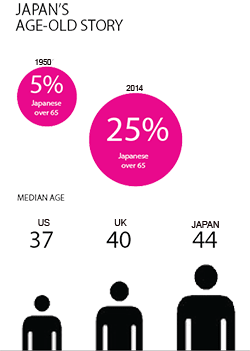The Silver Economy: Japan embraces future of robot care

Roula Khalaf, Editor of the FT, selects her favourite stories in this weekly newsletter.
If you are planning to grow old in Japan, it might help to have spent your childhood enjoying robot-filled anime and manga fantasies. Because in the Japan of the future, ageing humans will spend a lot more time interacting with machines.
According to strategists in Japan’s government and big technology companies, the hospitals, nursing homes and other environments inhabited by the country’s fast-growing ranks of very old people are to become increasingly filled with robots and robot-like automated devices.
Such devices will transform not only the way the elderly are cared for – allowing them to stay more independent longer, boosters say – but also the economy. The government estimates that the value of Japanese robot production will grow more than sixfold over the next two decades, to Y9.7tn, not far off the Y11tn of televisions, appliances and other consumer electronics the country produced last year.
FT series

How industries ranging from technology to entertainment are waking up to the opportunities provided by the world’s rapidly ageing population
Further reading
Much of the growth is expected to come not from the factory-based industrial robots that have been mainstays of the robotics sector until now, but from personal devices for homes and institutions.
“I’m convinced that the use of robots will bring big changes to people’s lives and to industry,” Shinzo Abe, prime minister, said recently during a tour of a Tokyo nursing home that has already introduced new technology to reduce the physical strain on caregivers.
Some of its staff wear a device that looks like a backpack with a pair of tentacles that wrap round the front of their legs; the extensions provide a mechanical boost when the staff lift patients out of beds or wheelchairs. “It’s difficult work and many nursing care workers don’t stick it out for very long, so this sort of thing will become more necessary,” says Kiyokuni Goshima of the Association for Technical Aids, a group that promotes the use of robots in old-age care and medicine.

Relatively few devices have been approved for real-world use so far, but many are in development or being assessed in clinical trials. Panasonic, for instance, is working on a bed that transforms into a wheelchair: the bed splits in half lengthwise and one half folds into the shape of a chair, obviating the need to lift infirm people out of one apparatus and into the other.
Toyota is building gyroscopic balance boards to train stroke victims to regain control over their limbs and remote-controlled “partner robots” that can scoot around rooms and pick up objects. The automaker has been refining its devices in clinical studies at a university hospital in suburban Nagoya since 2007, and this autumn it plans to start leasing the balance board and a motorised leg brace used in walking exercises to 20 more hospitals around the country.
Lesser-known names are also involved. Yaskawa Electric, a manufacturer of industrial robots, this year unveiled a machine designed to help carry bedridden people to a wheelchair or toilet, enabling one care worker to perform the task instead of two. It plans to begin real-world tests at 11 nursing homes in November, and hopes to start selling the machine in 2016.
The main force behind the push for such technology is demographics. Japan’s population is both ageing and shrinking, meaning that every year there are more elderly people who need care and fewer working-age people available to provide it. Even now, there are nearly two nursing home jobs on offer for every applicant, according to official labour statistics; the health ministry estimates that 1m more care workers will be needed by 2025.

To some degree, at least, robots are seen as a substitute for foreign labour. New arrivals fill many jobs in hospitals and nursing homes in western countries, but they are scarce in immigration-averse Japan. Mr Abe wants to expand a six-year-old guest-worker programme for nurses and care workers from the Philippines and Indonesia, but he has his work cut out to address the labour shortage. Since the programme began in 2008, just 1,562 applicants have been admitted, and attrition rates are reported to be high.
The government is meanwhile taking steps to speed up development and adoption of nursing technology. Starting next year, families will be able to use the proceeds of state-run home-nursing insurance to pay for robotic help. And to reduce costs – a big barrier to take-up – it last year began offering Y2.4bn in subsidies to developers who aim to build care robots priced at Y100,000 or less.
Recipients and potential beneficiaries of such care seem amenable. In a survey last year by Orix Living, a nursing home operator, 80 per cent of respondents said they would not object to relying on robots to some degree in old age. When the alternative is relying on humans for things you could once do easily yourself – picking up a television remote, going to the toilet – the answer makes sense. The most common reason given, by six in 10 respondents, was that robot helpers would free them from “bothering others”.
Comments